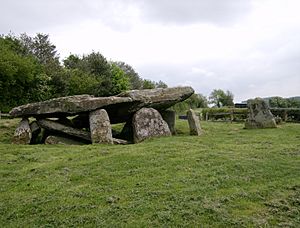Arthur's Stone, Herefordshire facts for kids
Quick facts for kids Arthur's Stone |
|
|---|---|

Arthur's Stone
|
|
| Location | Herefordshire, England, UK |
| OS grid reference | SO318430 |
| Lua error in Module:Location_map at line 420: attempt to index field 'wikibase' (a nil value). | |
Arthur's Stone, Herefordshire is a Neolithic chambered tomb, or Dolmen, dating from 3,700 BC – 2,700 BC and is situated on the ridge line of a hill overlooking both the Golden Valley, Herefordshire and the Wye Valley, Herefordshire.
Contents
Location
It is located between the villages of Dorstone and Bredwardine, and more generally between Hereford to the east and Hay-on-Wye to the west, at Ordnance Survey . The tomb commands an elevated view to the south of the Golden Valley and the Brecon Beacons in the distance, and is bounded to the north by a small road (Arthur's Stone Lane) which dissects what would originally have been the site of the tomb's elongated mound.
Description
The tomb is topped by a large capstone, estimated to weigh more than 25 tonnes. The capstone rests on nine uprights and there is a curved, 4.6 metre long entrance passageway.
To the north, there was once a cup-marked stone called the Quoit Stone. This can no longer be clearly seen, and now a stone to the south of the monument has become known as the Quoit Stone.
The stones would originally have been buried within a mound, aligned north-south and of approximately 25 metres in length with an east-facing entrance and a south-facing false portal. The mound is now, however, almost completely eroded and the capstone is broken with a large section fallen from its underside.
The site is defined and protected by a wooden fence.
The site is seen as a northerly outlier of the well known Severn-Cotswold tomb Group of chambered tombs and one of five Neolithic tombs in the local area.
Etymology
The tomb is one of many prehistoric monuments in western England and Wales to be linked with the legend of King Arthur. Some tales suggest the tomb was built to mark the location of one of King Arthur's battles, while others tell that the stones were already present when Arthur slew a giant on the spot, who fell onto the stones and left indentations in one of them, which remain to this day. Others suggest the indentations on the Quoit Stone were left by Arthur's knees or elbows as he knelt there to pray.
History
During the Wars of the Roses, a knight named Turberville was killed in a duel here by another knight, Thomas ap Griffith.
On 17 September 1645, King Charles gathered his army here and dined at the stone before spending the night at Holme Lacy.
Until the mid 19th century, celebrations with dancing were held at the stone, and a Baptist service used to be held there on the fourth Sunday in July.
CS Lewis was inspired by the Golden Valley and the Wye Valley particularly when writing his Narnia; the stone table upon which Aslan the Lion is sacrificed is said to be based upon Arthur’s Stone.
See also
 In Spanish: Piedra de Arturo para niños
In Spanish: Piedra de Arturo para niños

